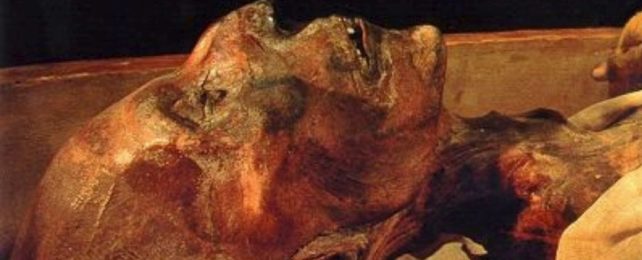Ramesses II, often revered as the 'greatest pharaoh' in Egyptian history, is a man of many faces.
In statues and drawings from more than 3,000 years ago, the sacred sovereign is depicted as a handsome, godly man with a rounded face, a prominent nose, and high cheekbones.
His mummy, which was uncovered in 1881, holds fewer subjective details. Its structure has been used to recreate the pharaoh's face multiple times by scientists, historians, and artists over the years.
In some iterations, Ramesses II's nose is strongly hooked. In others, there is less of a bump.
Depending on where you look online, the pharaoh's eyes range from beady to bug-eyed. And the very shape of his face is either depicted as round and squat, or long and thin.
Researchers at Liverpool John Moores University in the United Kingdom have now joined forces with Egyptian mummy expert and radiology professor Sahar Saleem of Cairo University to 'digitally unwrap' the pharaoh's remains and visualize his face in greater detail than ever before.
The work was meticulously done. CT scans and photographs of the mummy, which is now housed in the National Museum of Egyptian Civilization in Cairo, were combined with historical data to build the pharaoh's face from the bones up.
Caroline Wilkinson, a forensic anthropologist and leader of the Face Lab at Liverpool John Moores, says the most prominent features on the mummy's face are its strong jaw and its wide nasal bone, which sits "between the eyes, very high and very pronounced."
Once the overall facial structure was determined, the information was plugged into the same software that is used in criminal reconstructions. Based on the underlying bones and measurements of facial muscle thickness from Egyptian populations, researchers rebuilt the overlying muscles and ligaments.
"The stronger a muscle is where it is anchored, the more its attachments will leave visible marks on the surface of the skull," explains Wilkinson.
The result is an older man with a long face, wide aquiline nose, closely spaced eyes, bushy grey eyebrows, and a broad mouth with a thin upper lip as can be seen below.

The final layers added to the reconstruction were the pharaoh's skin and hair.
The skin tone was chosen based on what is thought to have been common in Egypt at the time. Meanwhile, the hair color was based on evidence, including microscopic studies of the locks of Ramesses II and other fair-haired mummies, which suggest he once sported a full head of red hair.
In ancient Egypt, red hair was perceived as a godly trait, both feared and respected, and Ramesses II himself was often depicted as a deity in drawings. It's unclear whether Ramesses II's red hair gave him a leg up as a leader, or if red hair became a sign of leadership in part because of his success.
While we can never be sure what this revered ruler might once have looked like, Wilkinson told Newsweek that her team tested their facial reconstruction methods using CT scans of living donors and found 70 percent of the details came within millimeters of the person's actual facial structure.
Ramesses II is thought to have died at the age of 92, after a 66-year-long reign from 1279 to 1213 BCE, which means his mummy is frozen in old age.
Nevertheless, Wilkinson, Saleem, and team have used three-dimensional age regression techniques to reconstruct a younger version: a middle-aged Ramesses II at the peak of his reign.
As you can see in the image below, not a lot has changed from the older version, other than his wrinkles, which have been smoothed over, his jowls, which are somewhat lifted, and his hair, which is far more abundant.

"Bringing Ramesses' face to life in his old age and as a young man reminds the world of his legendary status," Saleem told the online radiology magazine Aunt Minnie Europe.
The team is now also working on a reconstruction of King Tutankhamen's face using similar techniques. It follows other research from Saleem to study the face of King Amenhotep I (1525-1504 BCE), research which was published in Frontiers in Medicine.
